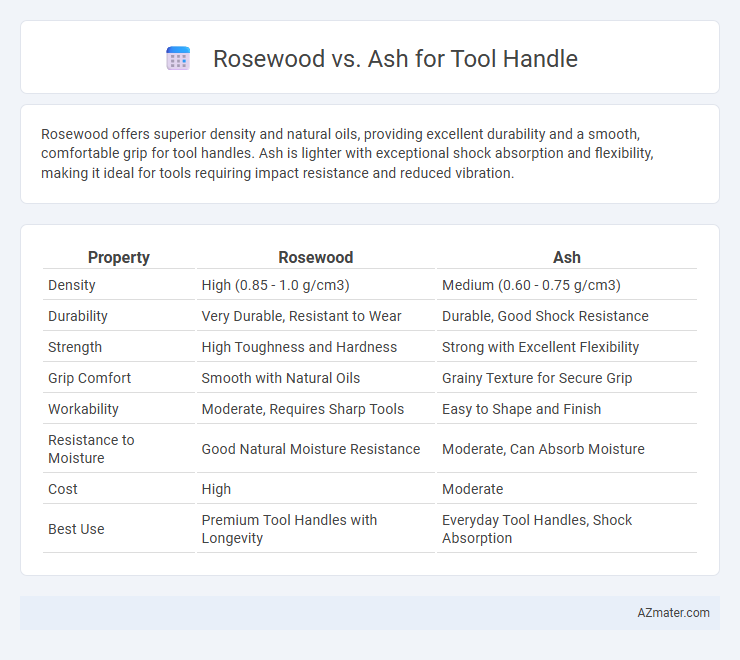Rosewood offers superior density and natural oils, providing excellent durability and a smooth, comfortable grip for tool handles. Ash is lighter with exceptional shock absorption and flexibility, making it ideal for tools requiring impact resistance and reduced vibration.
Table of Comparison
| Property | Rosewood | Ash |
|---|---|---|
| Density | High (0.85 - 1.0 g/cm3) | Medium (0.60 - 0.75 g/cm3) |
| Durability | Very Durable, Resistant to Wear | Durable, Good Shock Resistance |
| Strength | High Toughness and Hardness | Strong with Excellent Flexibility |
| Grip Comfort | Smooth with Natural Oils | Grainy Texture for Secure Grip |
| Workability | Moderate, Requires Sharp Tools | Easy to Shape and Finish |
| Resistance to Moisture | Good Natural Moisture Resistance | Moderate, Can Absorb Moisture |
| Cost | High | Moderate |
| Best Use | Premium Tool Handles with Longevity | Everyday Tool Handles, Shock Absorption |
Introduction to Tool Handle Materials
Rosewood and ash are prominent materials used in tool handle manufacturing due to their unique mechanical properties and durability. Rosewood offers exceptional hardness and natural resistance to impact and moisture, making it ideal for heavy-duty tools requiring precision and longevity. Ash is favored for its superior flexibility, shock absorption, and lightweight characteristics, providing ergonomic comfort and reduced fatigue during prolonged use.
Overview of Rosewood and Ash Characteristics
Rosewood is dense, heavy, and naturally oily, offering excellent durability and a smooth finish that resists moisture and wear, making it ideal for tool handles requiring strength and longevity. Ash is lighter and more flexible with a straight grain, providing shock absorption and ease of shaping while maintaining good strength, suitable for tools that demand a balance between toughness and comfort. Both woods are prized in woodworking, with rosewood delivering premium hardness and resistance, and ash offering lightweight resilience and flexibility.
Durability and Strength Comparison
Rosewood offers superior durability and natural oil content, making it highly resistant to wear and moisture, which enhances its longevity for tool handles. Ash, known for its exceptional strength and shock absorption, delivers excellent impact resistance and flexibility, reducing handle breakage under heavy use. When comparing the two, rosewood is favored for its hardness and moisture resistance, while ash excels in toughness and shock resilience, making the choice dependent on specific tool demands.
Weight and Balance Considerations
Rosewood tool handles tend to be heavier, providing excellent durability and a solid grip preferred for tasks requiring stability. Ash handles offer a lighter weight, enhancing maneuverability and reducing user fatigue during prolonged use. The balance of rosewood handles is often more top-heavy, while ash handles provide a more evenly distributed feel, ideal for precision work.
Grip and Comfort
Rosewood offers a dense, smooth texture that provides a firm, secure grip, reducing hand fatigue during extended use. Ash, known for its lightweight and slightly porous surface, allows for better shock absorption and breathability, enhancing overall comfort. While rosewood excels in durability and a polished feel, ash promotes ergonomic handling with natural cushioning.
Resistance to Moisture and Environmental Factors
Rosewood exhibits superior resistance to moisture and environmental factors compared to Ash, making it an ideal choice for tool handles exposed to humid or wet conditions. Its dense, oily grain structure repels water and resists swelling, cracking, and decay, unlike the more porous and absorbent Ash which can warp or degrade over time with exposure. Consequently, Rosewood handles maintain durability and structural integrity in challenging environments, enhancing tool longevity and user safety.
Workability and Shaping Ease
Rosewood offers excellent workability due to its fine grain and natural oils, making it easier to shape and smooth without splintering. Ash provides superior shock resistance and is lighter, but its open grain structure can require more effort during sanding and finishing. Both woods are durable, yet Rosewood's dense composition allows for more precise shaping with less wear on tools.
Cost and Availability
Rosewood tool handles typically have a higher cost due to their dense grain and limited supply, making them a premium choice for craftsmanship and durability. Ash offers a more affordable alternative, widely available with a lighter weight and excellent shock absorption, preferred for budget-conscious buyers. The availability of Ash is generally consistent, while Rosewood is subject to export restrictions and sustainability concerns, impacting its market presence.
Aesthetic Appeal and Finishing Options
Rosewood offers a rich, dark grain with natural oils that provide a smooth, polished finish favored for luxury tool handles, enhancing aesthetic appeal with deep hues and unique patterns. Ash features a lighter, more uniform color with a pronounced grain, allowing for versatile finishes from matte to glossy, ideal for a modern, clean look. Both woods accept stains and oils well, but rosewood's natural sheen often reduces the need for heavy finishing, while ash's porous texture requires more finishing layers to achieve the desired smoothness and protection.
Choosing the Right Wood: Rosewood or Ash for Tool Handles
Rosewood offers exceptional durability, density, and natural resistance to wear, making it ideal for heavy-duty tool handles requiring long-lasting strength and smooth grip. Ash provides superior shock absorption and a lightweight feel, reducing hand fatigue during extended use without sacrificing toughness. Choosing between Rosewood and Ash depends on the balance between resilience, comfort, and the specific demands of your tool's application.

Infographic: Rosewood vs Ash for Tool Handle
 azmater.com
azmater.com